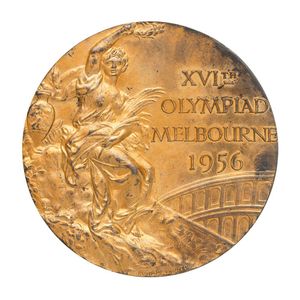Melbourne 1956 Olympic Gold Medal for Men's Swimming
The games of the XVI Olympiad Gold Medal Melbourne 1956 awarded for the 400m men's freestyle swimming final race held on 4 December 1956. From 1928 to 1968, the medals for the Summer Olympic Games were identical, depicting a design first used for medals awarded at the games of the IX Olympiad (Amsterdam 1928), created by Florentine artist Giuseppe Cassioli (1865-1942) and chosen after a competition organised by the international Olympic Committee. The obverse embossed with the goddess of victory, holding a palm in her left hand and a winner's crown in her right. Embossed with the specific inscription 'XVIth Olympiad Melbourne 1956' and inscribed with the name of the mint, K.G. Luke Ltd. The reverse depicts an Olympic champion carried in triumph by the crowd, with the Olympic stadium in the background. Gilt silver 74.50 grams; diameter 51 mm. Provenance: Murray rose Am, Sydney. The Estate of the late Murray rose Am, Sydney. Exhibited: National sports Museum, Melbourne cricket ground, Melbourne, 1987 - 21 September 2020. Literature: Murray rose, life is Worth swimming, Arbon Publishing, Sydney, 2013, pp. 78, 189, 221 (illustrated)
You must be a subscriber, and be logged in to view price and dealer details.
Subscribe Now to view actual auction price for this item
When you subscribe, you have the option of setting the currency in which to display prices to $Au, $US, $NZ or Stg.
This item has been sold, and the description, image and price are for reference purposes only.
- Embossed / Repousse - Embossing, also known as repousse, is the technique of decorating metal with raised designs, by pressing or beating out the design from the reverse side of the object.It is the opposite of chasing, where the decoration is applied from the front. An embossed or repoussed object may have chasing applied to finish off the design.
- Obverse - Obverse means the front face of a coin or medal, and the reverse means the back face. The obverse of a coin is commonly called heads, because it often depicts the head of a monarch or famous person.
This item has been included into following indexes:
-
Olympic Games memorabilia
- gold medals 3
- medals and badges 201
-
Olympic Games memorabilia, by city
- Amsterdam, 1928 14
- Grenoble 23
- Melbourne, 1956 306
- Sydney, 2000 191
